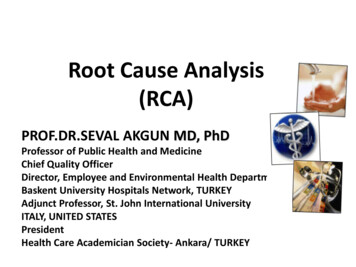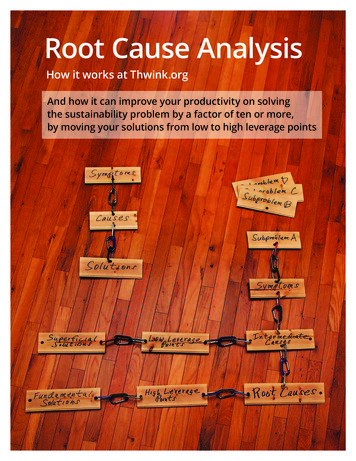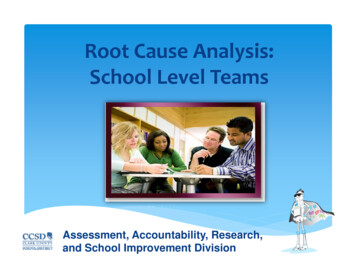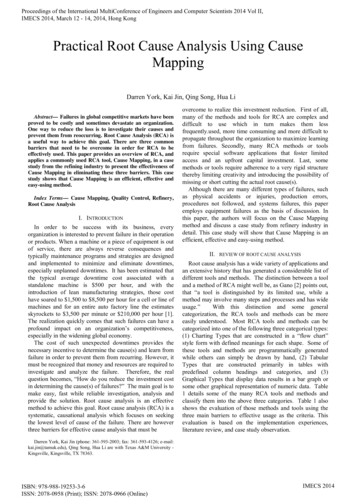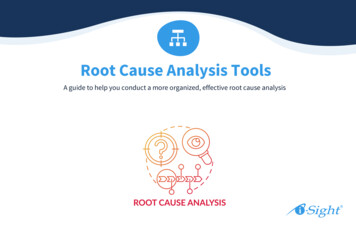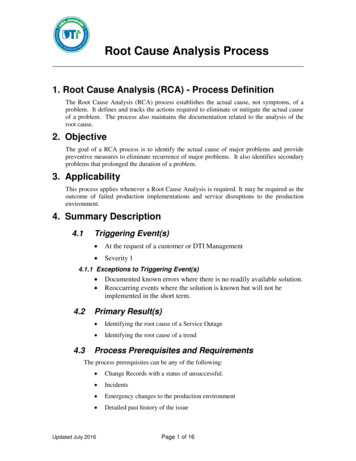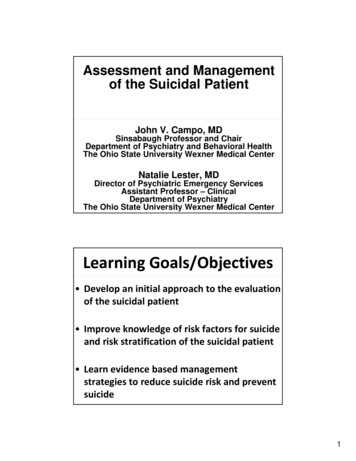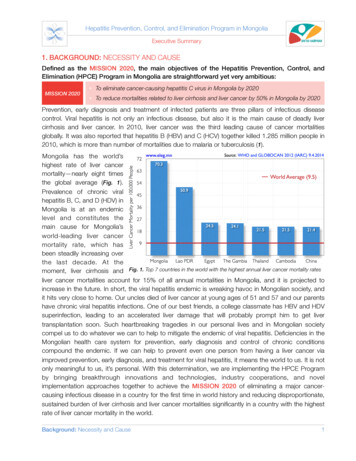
Transcription
Hepatitis Prevention, Control, and Elimination Program in MongoliaExecutive Summary1. BACKGROUND: NECESSITY AND CAUSEDefined as the MISSION 2020, the main objectives of the Hepatitis Prevention, Control, andElimination (HPCE) Program in Mongolia are straightforward yet very ambitious:MISSION 2020 To eliminate cancer-causing hepatitis C virus in Mongolia by 2020 To reduce mortalities related to liver cirrhosis and liver cancer by 50% in Mongolia by 2020Prevention, early diagnosis and treatment of infected patients are three pillars of infectious diseasecontrol. Viral hepatitis is not only an infectious disease, but also it is the main cause of deadly livercirrhosis and liver cancer. In 2010, liver cancer was the third leading cause of cancer mortalitiesglobally. It was also reported that hepatitis B (HBV) and C (HCV) together killed 1.285 million people in2010, which is more than number of mortalities due to malaria or tuberculosis (1).Mongolia has the world’shighest rate of liver cancermortality—nearly eight timesthe global average (Fig. 1).Prevalence of chronic viralhepatitis B, C, and D (HDV) inMongolia is at an endemiclevel and constitutes themain cause for Mongolia’sworld-leading liver cancermortality rate, which hasbeen steadily increasing overthe last decade. At themoment, liver cirrhosis and Fig. 1. Top 7 countries in the world with the highest annual liver cancer mortality ratesliver cancer mortalities account for 15% of all annual mortalities in Mongolia, and it is projected toincrease in the future. In short, the viral hepatitis endemic is wreaking havoc in Mongolian society, andit hits very close to home. Our uncles died of liver cancer at young ages of 51 and 57 and our parentshave chronic viral hepatitis infections. One of our best friends, a college classmate has HBV and HDVsuperinfection, leading to an accelerated liver damage that will probably prompt him to get livertransplantation soon. Such heartbreaking tragedies in our personal lives and in Mongolian societycompel us to do whatever we can to help to mitigate the endemic of viral hepatitis. Deficiencies in theMongolian health care system for prevention, early diagnosis and control of chronic conditionscompound the endemic. If we can help to prevent even one person from having a liver cancer viaimproved prevention, early diagnosis, and treatment for viral hepatitis, it means the world to us. It is notonly meaningful to us, it’s personal. With this determination, we are implementing the HPCE Programby bringing breakthrough innovations and technologies, industry cooperations, and novelimplementation approaches together to achieve the MISSION 2020 of eliminating a major cancercausing infectious disease in a country for the first time in world history and reducing disproportionate,sustained burden of liver cirrhosis and liver cancer mortalities significantly in a country with the highestrate of liver cancer mortality in the world.Background: Necessity and Cause1
01arting Point in 2013 All Oral DAA (Fixed Dose)2Enter description forWave 23Enter description forWave 34Enter description forWave 45Post %300%1,3005,20015,600- Elimination)cenario: 95% Strategy Cost 95% F2 F2 F0135%90%90%80%80%80%180%80%80%135%90%90%100%500%0 4200%150100060%95%95% F2 F2 F066%90%90%80%80%80%80%80%80%66%90%90%USDTotalCost of Strategy (2012-2030)100%200%500%60%95%95% F2 F2Total Infected – 0%20,000100%200%500%15,00010,00060%95%95%5,000 F2 F2 100%100%Hepatitis Prevention, Control,and EliminationProgram100%in 0- 2Page 2 5%95%95% F0 F0 %95%95% -F0 F0 F090%90%90%80%80%80%80%80%80%90%90%90%Total Treated (Incremental)104,348120%167% (2012-2030)100%95%95%95% F0 F0 – F1 F0Total 0 F0 F0 ve Summary2. MISSION AND EXPECTED RESULTSUSD (M)Is the MISSION 2020 attainable? Based on solid scientific findings, facts, and evidences, weconfidently infer that the MISSION 2020 is indeed attainable. In our epidemiological study thatdetermined the prevalence of viral hepatitis in Mongolia in 2013, we discovered that there is a cohorteffect for chronic HCV wherein some high risk factor in the past is no longer occurring, which in turnmeans that a probability for re-infection of HCV after getting treatment is less pronounced (Fig. 2).Based on this scientific finding, we conclude that it is practically feasible to eliminate HCV in Mongoliaby utilizing revolutionarynew HCV treatments.-USD (M)In addition, using the agedistribution of the viralhepatitis prevalence andpopulation statistics, weestimate that roughly 115Kpeople have chronic HCVinfection, while roughly200K peoplehave chronic 17,2532030)102,667Infections Averted (2012-2030)Infections Averted (2012-2030)17,633HBV infection in Mongolia.These populationsizesared – F2Total Infected– F3Total Infected – Cirrhosisillions)Liver TransplantsLiver Related Deaths20,000m25,000a3 n a g e a b l e . I n o t h e r Fig. 2. PrevalenceofHBV and HCV among Mongolian population in different age groups1,00020,000315,000800words, with relatively small viral hepatitis prevalent population sizes combined with the cohort effect for15,0002600HCVinfection, Mongolia might be the10,000only country where viral hepatitis is highly prevalent and causes210,00040015,000devastatingeffects on its society, yet 5,000it200is possible to eliminate HCV and to control HBV in relatively1W4 W5shortamount of time. In fact, according- to hepatitis treatment simulation study that we published inIncr Strategy CostJanuary 2015 issue of the Journal of Viral Hepatitis (2, 3, and 4) along with colleagues, elimination of2030)10,053Averted (2012-2030)Cases Averted (2012-2030)13,753M hronic InfectionsHCVMongoliacan 14,764be25achieved Cirrhoticby 2020if Savedroughly15K patientstreated annually starting in2015. According to thisalthcareCostTotalInfectedNewmp CirrhosisTotalInfected– HCCTotalInfectionsMortality113,838treatment dynamics model,1120,0002,5001,0003,5003,000100,000the total number of HCV12,4008002,50080,00012,3006002,000infected would decline by60,0001,50002,20040040,0001,00091% in 2030 and over7,25502,10020020,0005002,00027,000 lives (Fig. 3) will be- saved from dying of ctionsAvoided(2012-2030)7302030)1,952HCC Cases Averted (2012-2030)798Lives Saved (2012-2030)27,021 cirrhosis or liver cancer byFig. 3. HCV treatment dynamics modeling output: Elimination of HCV in Mongolia by 2020 2030 in the process ofeliminating HCV in Mongolia. These results are truly remarkable and demonstrate the true impact of theix base case Checked Out.xlsmPage 1 of 2HPCE Program in making a difference in lives of ordinary Mongolians. Finally, working with the OnomFoundation and its partners, you can set a shining example in eradicating viral hepatitis for the wholeworld to follow suit since the elimination of HCV and control of HBV and HDV in Mongolia will serve asa model for other countries in the world with high prevalence and burden of viral hepatitis.Mission and Expected Results2
Hepatitis Prevention, Control, and Elimination Program in MongoliaExecutive Summary3. IMPLEMENTATION OVERVIEWThe Hepatitis Prevention, Control, and Elimination Program in Mongolia is a comprehensive nationalprogram that is divided into three main intrinsically inter-dependent campaigns with specific focuses onprevention, early diagnosis, and treatment:Prevention Campaign—Nationwide public health campaign will be conducted to increase awarenessand knowledge of Mongolian public about viral hepatitis and its deadly consequences and ways ofpreventing viral hepatitis infection and protecting loved-ones from this life-threatening disease. Analysisof data from public knowledge and awareness assessment surveys will be used to regularly optimizethe design and execution of the public health campaign. In addition to the public health campaign,HBV vaccination of high-risk groups such as healthcare workers and emergency responders will beintensified around Mongolia. In fact, the plan is to vaccinate all healthcare workers and other high-riskgroups in Mongolia against HBV and install a system in place to continue the vaccination. With thesemeasures, prevalence of HBV and HDV will be controlled and ultimately lowered in Mongolia.Screening and Early Diagnosis Campaign— Before dwelling into the details of the screeningcampaign, we would like to provide an interesting statistics. According to the US Central IntelligenceAgency, Mongolia has a population of 2.95 million, while it has 3.4 million mobile phone subscribers,indicating extensive penetration of mobile phones. Not only the penetration is high, but also cellularnetwork effectively covers every corner of the country despite Mongolia’s enormous land mass. Withsuch ubiquitous mobile phone usage among Mongolian population, mobile phones are the mosteffective communication tool for combating the viral hepatitis endemic that we can extensively utilizenot only in the decentralized screening and early diagnosis campaign, but also in hepatitis preventionand treatment activities. Now getting back to the screening campaign, we would like to note that thereare approximately 315,000 people with chronic viral hepatitis infections in Mongolia, according of ourrecent population-based epidemiological study of viral hepatitis prevalence in Mongolia. Identifying andregistering these people with chronic hepatitis infections will be the key to achieving the MISSION2020 of the HPCE Program. Therefore, it is our plan to conduct decentralized nationwide screening forviral hepatitis infection, to identify and register HBV and HCV infection status of everyone in Mongoliausing inexpensive, on-site, rapid tests that can be performed at the 567 primary and secondaryhealthcare facilities throughout Mongolia. Once hepatitis testing is performed, doctor would send thetest result via SMS message to the Mobile Messaging Platform along with individual’s name andnational identification number to register into the National Viral Hepatitis Database. To demonstrate itsfeasibility, we have already piloted this system and have 5806 valid registrations into the National ViralHepatitis Database as of January 12, 2015. In other words, we will be using the power ofcrowdsourcing to register every individual tested for viral hepatitis infections into the National ViralHepatitis Database via the Mobile Messaging Platform. Blood samples of people with viral hepatitisinfections will be collected using ViveBio’s new class of ambient temperature, dry blood transportationsystem for further quantitative testing at central laboratories to determine their treatment eligibility.Treatment Campaign—Thanks to industry cooperation for the HPCE Program, the most effective andbreakthrough medicines for chronic viral hepatitis will be introduced in Mongolia with over 98%discount of the world market price. For instance: Gilead Sciences, a biopharmaceutical giant that isleading research, development, and introduction of revolutionary new treatments for chronic viralhepatitis, is a partner of the HPCE Program in Mongolia. Thanks to Gilead’s Access PartnershipsBrief Overview on Implemention3
Hepatitis Prevention, Control, and Elimination Program in MongoliaExecutive SummaryProgram in which Gilead makes it a priority to increase access to these life-saving medicines forpeople who can benefit from them, regardless of where they live or their economic status, GileadSciences has taken concrete steps to reduce the costs of these life-saving medications for HCV andHBV by over 98% in Mongolia—an extraordinary in kind commitment of over US 12 Billion. In fact,official registrations of these life-saving breakthrough medicines with the Ministry of Health and Sportsof Mongolia. As part of the treatment campaign, over 110,000 people with chronic HCV will be curedby 2020. Over 100,000 people with chronic HBV will be enrolled into antiviral treatment regimen. As aresult, mortalities related to liver cirrhosis and liver cancer in Mongolia will be reduced by 50% by 2020and cancer-causing HCV will be eliminated in Mongolia.On top of these campaigns, we are also establishing a comprehensive research program to investigatea number of aspects ranging from health economics to clinical trials.4. UNIQUE PUBLIC-PRIVATE PARTNERSHIP AND COLLABORATIONThe Hepatitis Prevention, Control, and Elimination Program is not a straightforward governmentprogram, rather it is a comprehensive national program put forward by the Onom Foundation, a civilsociety institution that has the most in-depth institutional knowledge and hands-on expertise on allaspects of viral hepatitis endemic in Mongolia. To date, the Onom Foundation along with its partnershas successfully carried out a viral hepatitis prevalence study, conducted public health campaigns,organized national conferences and training sessions for healthcare professionals, orchestratedroundtable discussions among policy makers, developed a comprehensive national program, andbrought all stakeholders together to agree on an action plan to combat viral hepatitis in Mongolia.Fig. 5. A photo taken with Mr. TsakhiaElbegdorj, President of Mongolia inJune of 2014. President Elbegdorjpersonally committed to support theHepatitis Prevention, Control, andElimination Program in Mongolia. In thephoto, from the left: NaranjargalDashdorj, MD, PhD, Co-Founder andC h i e f E x e c u t i v e O f fi c e r, O n o mFoundation, Naranbaatar Dashdorj,PhD, Co-Founder and Chairman, OnomFoundation, Aaron Brinkworth, SeniorD i r e c t o r, A c c e s s O p e r a t i o n s &Emerging Markets, Gilead Sciences,Inc, Clifford Samuel, Vice President,Access Operations & EmergingMarkets, Gilead Sciences, Inc. Mr.Ts a k h i a E l b e g d o r j , P re s i d e n t o fMongolia, Prof. P. Nymadawa, Vice President of the Mongolian Academy of Sciences and Former Minister of Health, J.Amarsanaa, MD, PhD, Former Vice Minister of Health of Mongolia, Betty Chiang, MD, Medical Director, Access Operations &Emerging Markets, Gilead Sciences, Inc.Because of this unique situation, the Hepatitis Prevention, Control, and Elimination Program calls for aninnovative public-private partnership along the lines of the Smart Government Platform that Mr.Tsakhia Elbegdorj, the President of Mongolia, proposed at the publicly broadcast event, “From aBig Government to a Smart Government” on November 26, 2013. President Elbegdorj definesUnique Partnership and Collobration4
Hepatitis Prevention, Control, and Elimination Program in MongoliaExecutive Summary“Smart Government” as a combination of skilled people, technological advancements, research, andlaws that all add up to creating a new mindset of how government must serve its citizens and enable(and not hinder) private sector and civil society development. In our opinion, the Hepatitis Prevention,Control, and Elimination Program provides an ideal example of this new model of government servingits citizens by enabling civil society initiatives.To implement the HPCE Program in Mongolia, we are augmenting a worldwide cooperation amongfunding agencies, research universities, healthcare companies, all relevant public and privateinstitutions, and the Government of Mongolia. In this cooperative process, the Onom Foundation isserving as an anchor organization along with its partners to coordinate the implementation of theHPCE Program in Mongolia. Currently, the HPCE Program has the support of industry leaders such asGilead Sciences, Abbott, Novartis, Sysmex Corporation, BMS, ViveBio, Eiger Biopharmaceuticals,Echosens, Daktari Diagnostics, and others. In addition, there are a number of academic and researchinstitutions and faculty members at these institutions that we are exchanging ideas and activelypursuing some research collaborations. Examples of such institutions include Stanford University,University of Chicago, Harvard University, George Washington University, Center for Disease Analysis,and Mongolian National University of Medical Sciences. Furthermore, we have been interacting withand getting helpful feedbacks from experts at the World Health Organization, World Hepatitis Alliance,US National Institutes of Health and Centers for Disease Control and Prevention on the design of theHPCE Program. Finally, the HPCE Program has the full support of the Government of Mongolia, andwe enjoy close cooperation at every level of the Government of Mongolia, starting with the Parliamentand Ministry of Health and Sports. We would like to note that all of these partners are bringingenormous value to the HPCE Program. With these commitments and concrete steps on the ground inMongolia, there is an unmistakable agglomeration of cooperative actions and forces united in the visionof eliminating HCV and controlling HBV and HDV in Mongolia, which in turn will serve as a model forother countries in the world in their fight against viral hepatitis.REFERENCES1. Lozano R et al. 2012. Global and Regional Mortality from 235 Causes of Death for 20 Age Groups in 1990 and 2010: ASystematic Analysis for the Global Burden of Disease Study 2010. Lancet 380(9859): 2095-2128.2. Saraswat V et al. 2015. Historical Epidemiology of Hepatitis C Virus (HCV) in Select Countries – Volume 2. Journal of ViralHepatitis 22(Suppl. S1): 6-25.3. Hatzakis A et al. 2015. The Present and Future Disease Burden of Hepatitis C Virus (HCV) Infections with Today’sTreatment Paradigm – Volume 2. Journal of Viral Hepatitis 22(Suppl. S1): 26-45.4. Gane E et al. 2015. Strategies to Manage Hepatitis C Virus (HCV) Infection Disease Burden – Volume 2. Journal of ViralHepatitis 22(Suppl. S1): 46-73.Unique Partnership and Collobration5
Executive Summary Background: Necessity and Cause 1 Fig. 1. Top 7 countries in the world with the highest annual liver cancer mortality rates. 2. MISSION AND EXPECTED RESULTS Is the MISSION 2020 attainable? Based on solid scientific findings, facts, and evidences, we .

